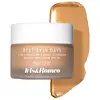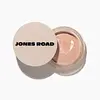What's inside
What's inside
 Key Ingredients
Key Ingredients

 Benefits
Benefits

 Concerns
Concerns

 Ingredients Side-by-side
Ingredients Side-by-side

Zinc Oxide 21%
Cosmetic ColorantWater
Skin ConditioningCaprylic/Capric Triglyceride
MaskingCoconut Alkanes
EmollientGlycerin
HumectantDimethicone
EmollientCetearyl Alcohol
EmollientDicaprylyl Carbonate
EmollientCandelilla/Jojoba/Rice Bran Polyglyceryl-3 Esters
EmulsifyingGlyceryl Stearate
EmollientHelianthus Annuus Seed Oil
EmollientCoco-Glucoside
CleansingSodium Stearoyl Lactylate
EmulsifyingPhenoxyethanol
PreservativePyrus Malus Fruit Extract
Skin ConditioningCoco-Caprylate/Caprate
EmollientRosa Damascena Flower Water
MaskingIsostearic Acid
CleansingLecithin
EmollientPolyhydroxystearic Acid
EmulsifyingPolyglyceryl-3 Polyricinoleate
EmulsifyingHydrolyzed Jojoba Esters
Skin ConditioningEthylhexylglycerin
Skin ConditioningMoringa Oleifera Seed Oil
EmollientTetrahexyldecyl Ascorbate
AntioxidantTocopherol
AntioxidantSorbitan Stearate
EmulsifyingTriethoxycaprylylsilane
Sodium Phytate
Xanthan Gum
EmulsifyingRosa Damascena Flower Extract
MaskingCocos Nucifera Oil
Masking1,2-Hexanediol
Skin ConditioningCaprylyl Glycol
EmollientButyrospermum Parkii Nut Extract
EmollientRosa Damascena Flower Oil
MaskingSodium Hyaluronate
HumectantHydroxyethyl Acrylate/Sodium Acryloyldimethyl Taurate Copolymer
Emulsion StabilisingCamellia Sinensis Leaf Extract
AntimicrobialGlucose
HumectantGlycine Soja Oil
EmollientPhytosterols
Skin ConditioningSorbitan Isostearate
EmulsifyingPotassium Sorbate
PreservativeSodium Benzoate
MaskingAlumina
AbrasiveMagnesium Oxide
AbsorbentTapioca Starch
Citric Acid
BufferingTitanium Dioxide
Cosmetic ColorantIron Oxides
Mica
Cosmetic ColorantZinc Oxide 21%, Water, Caprylic/Capric Triglyceride, Coconut Alkanes, Glycerin, Dimethicone, Cetearyl Alcohol, Dicaprylyl Carbonate, Candelilla/Jojoba/Rice Bran Polyglyceryl-3 Esters, Glyceryl Stearate, Helianthus Annuus Seed Oil, Coco-Glucoside, Sodium Stearoyl Lactylate, Phenoxyethanol, Pyrus Malus Fruit Extract, Coco-Caprylate/Caprate, Rosa Damascena Flower Water, Isostearic Acid, Lecithin, Polyhydroxystearic Acid, Polyglyceryl-3 Polyricinoleate, Hydrolyzed Jojoba Esters, Ethylhexylglycerin, Moringa Oleifera Seed Oil, Tetrahexyldecyl Ascorbate, Tocopherol, Sorbitan Stearate, Triethoxycaprylylsilane, Sodium Phytate, Xanthan Gum, Rosa Damascena Flower Extract, Cocos Nucifera Oil, 1,2-Hexanediol, Caprylyl Glycol, Butyrospermum Parkii Nut Extract, Rosa Damascena Flower Oil, Sodium Hyaluronate, Hydroxyethyl Acrylate/Sodium Acryloyldimethyl Taurate Copolymer, Camellia Sinensis Leaf Extract, Glucose, Glycine Soja Oil, Phytosterols, Sorbitan Isostearate, Potassium Sorbate, Sodium Benzoate, Alumina, Magnesium Oxide, Tapioca Starch, Citric Acid, Titanium Dioxide, Iron Oxides, Mica
Water
Skin ConditioningCaprylic/Capric Triglyceride
MaskingC12-15 Alkyl Benzoate
AntimicrobialCaprylic/Capric/Succinic Triglyceride
EmollientPropanediol
SolventSimmondsia Chinensis Seed Oil
EmollientOlea Europaea Fruit Oil
MaskingCoco-Caprylate/Caprate
EmollientDiisostearyl Malate
EmollientC9-12 Alkane
SolventPolyhydroxystearic Acid
EmulsifyingHydrogenated Castor Oil
EmollientRicinus Communis Seed Oil
MaskingHelianthus Annuus Seed Wax
Skin ConditioningStearalkonium Hectorite
Gel FormingEuphorbia Cerifera Wax
Polyglyceryl-3 Diisostearate
EmulsifyingPolyglyceryl-3 Polyricinoleate
EmulsifyingPhenoxyethanol
PreservativeCopernicia Cerifera Wax
Silica Silylate
EmollientSodium Chloride
MaskingPelargonium Graveolens Oil
MaskingTocopheryl Acetate
AntioxidantPolyglyceryl-6 Polyricinoleate
EmulsifyingTriethoxycaprylylsilane
Zingiber Officinale Root Oil
MaskingLecithin
EmollientSilica
AbrasiveBiosaccharide Gum-1
HumectantSodium Hyaluronate
HumectantMica
Cosmetic ColorantCI 77891
Cosmetic ColorantIron Oxides
Citronellol
PerfumingGeraniol
PerfumingLinalool
PerfumingLimonene
PerfumingCitral
PerfumingWater, Caprylic/Capric Triglyceride, C12-15 Alkyl Benzoate, Caprylic/Capric/Succinic Triglyceride, Propanediol, Simmondsia Chinensis Seed Oil, Olea Europaea Fruit Oil, Coco-Caprylate/Caprate, Diisostearyl Malate, C9-12 Alkane, Polyhydroxystearic Acid, Hydrogenated Castor Oil, Ricinus Communis Seed Oil, Helianthus Annuus Seed Wax, Stearalkonium Hectorite, Euphorbia Cerifera Wax, Polyglyceryl-3 Diisostearate, Polyglyceryl-3 Polyricinoleate, Phenoxyethanol, Copernicia Cerifera Wax, Silica Silylate, Sodium Chloride, Pelargonium Graveolens Oil, Tocopheryl Acetate, Polyglyceryl-6 Polyricinoleate, Triethoxycaprylylsilane, Zingiber Officinale Root Oil, Lecithin, Silica, Biosaccharide Gum-1, Sodium Hyaluronate, Mica, CI 77891, Iron Oxides, Citronellol, Geraniol, Linalool, Limonene, Citral
 Reviews
Reviews

Ingredients Explained
These ingredients are found in both products.
Ingredients higher up in an ingredient list are typically present in a larger amount.
This ingredient is an emollient, solvent, and texture enhancer. It is considered a skin-softener by helping the skin prevent moisture loss.
It helps thicken a product's formula and makes it easier to spread by dissolving clumping compounds.
Caprylic Triglyceride is made by combining glycerin with coconut oil, forming a clear liquid.
While there is an assumption Caprylic Triglyceride can clog pores due to it being derived from coconut oil, there is no research supporting this.
Learn more about Caprylic/Capric TriglycerideCoco-Caprylate/Caprate is created from fatty coconut alcohol, caprylic acid, and capric acid.
It is a lightweight emollient. Emollients create a thin barrier on the skin to trap moisture in. This helps keep your skin hydrated and soft.
Once applied, Coco-Caprylate/Caprate is absorbed quickly and leaves a silky feel.
Coco-Caprylate/Caprate may not be fungal acne safe.
Learn more about Coco-Caprylate/CaprateLecithin is a term for a group of substances found in the cell membranes of plants, animals, and humans. They are made up of mixture of phospholipids.
This ingredient has emollient and emulsifying properties.
As an emollient, lecithen helps soften the skin and creates a barrier to keep moisture in.
As an emulsifier, it also helps prevent water and oil ingredients from separating. Lecithin can also help ingredients be better absorbed by the skin.
This is because the phospholipids in lecithin produce liposomes. Liposomes help other ingredients get through the skin barrier.
Depending on the source of this ingredient, lecithin may not be fungal acne safe. This is because some sources of lecithin come from soybean oil, which may feed the malassezia yeast that feeds fungal acne.
We recommend reaching out to the brand you are purchasing from to inquire about the source of their lecithin.
Some other names for this ingredient include soy lecithin and deoiled soy lecithin.
Learn more about LecithinMica is a naturally occurring mineral used to add shimmer and color in cosmetics. It can also help improve the texture of a product or give it an opaque, white/silver color.
Serecite is the name for very fine but ragged grains of mica.
This ingredient is often coated with metal oxides like titanium dioxide. Trace amounts of heavy metals may be found in mica, but these metals are not harmful in our personal products.
Mica has been used since prehistoric times throughout the world. Ancient Egyptian, Indian, Greek, Roman, Aztec, and Chinese civilizations have used mica.
Learn more about MicaPhenoxyethanol is a preservative that has germicide, antimicrobial, and aromatic properties. Studies show that phenoxyethanol can prevent microbial growth. By itself, it has a scent that is similar to that of a rose.
It's often used in formulations along with Caprylyl Glycol to preserve the shelf life of products.
This ingredient is an emulsifier. It is created from Polyglycerin-3 and Ricinoleic Acid.
As an emulsifier, it prevents waters and oils from separating. According to a manufacturer this ingredient is fully biodegradable.
This ingredient may not be safe for Malassezia folliculitis due to its Ricinoleic Acid base. Ricinoleic Acid is a fatty acid derived from castor oil.
Learn more about Polyglyceryl-3 PolyricinoleatePolyhydroxystearic Acid is a soft wax made from castor oil.
It is is a texture thickener, emulsifier, and film-former. Emulsifiers prevent ingredients from separating, such as oils and waters.
Polyhydroxystearic Acid may not be fungal acne safe.
Learn more about Polyhydroxystearic AcidSodium Hyaluronate is hyaluronic acid's salt form. It is commonly derived from the sodium salt of hyaluronic acid.
Like hyaluronic acid, it is great at holding water and acts as a humectant. This makes it a great skin hydrating ingredient.
Sodium Hyaluronate is naturally occurring in our bodies and is mostly found in eye fluid and joints.
These are some other common types of Hyaluronic Acid:
Learn more about Sodium HyaluronateTriethoxycaprylylsilane is a silicone used to bind and stabilize ingredients.
As an emulsifier, it helps prevent ingredients from separating. This can help elongate the shelf life of products.
Triethoxycaprylylsilane is often used to coat mineral sunscreens ingredients to help give a better feel. It also helps reduce oxidative stress in sunscreens.
Learn more about TriethoxycaprylylsilaneWater. It's the most common cosmetic ingredient of all. You'll usually see it at the top of ingredient lists, meaning that it makes up the largest part of the product.
So why is it so popular? Water most often acts as a solvent - this means that it helps dissolve other ingredients into the formulation.
You'll also recognize water as that liquid we all need to stay alive. If you see this, drink a glass of water. Stay hydrated!
Learn more about WaterThis ingredient is a combination of red, black, and yellow iron oxide pigments. This combination of colors is usually found in foundation, because it results in a "skin" color.